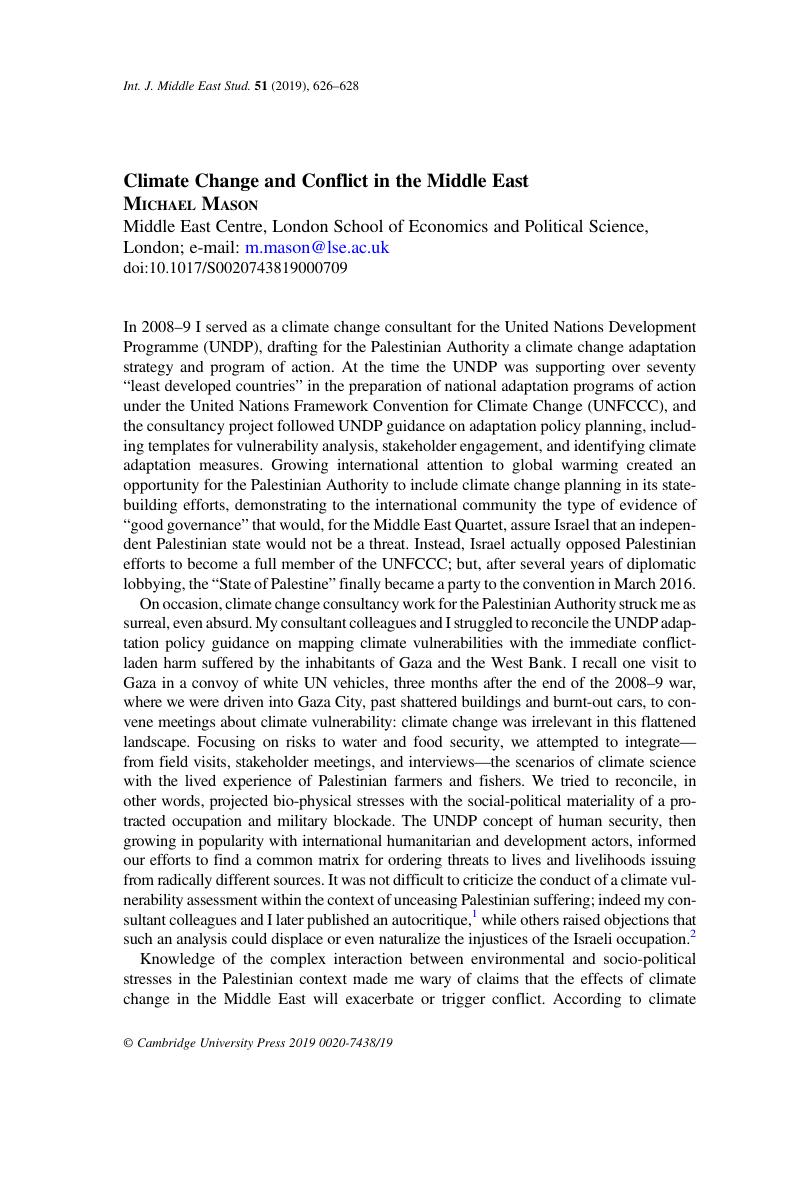Article contents
Climate Change and Conflict in the Middle East
Published online by Cambridge University Press: 28 August 2019
Abstract

- Type
- Roundtable
- Information
- Copyright
- Copyright © Cambridge University Press 2019
References
NOTES
1 Mason, Michael, Zeitoun, Mark, and Mimi, Ziad, “Compounding Vulnerability: Impacts of Climate Change on Palestinians in Gaza and the West Bank,” Journal of Palestine Studies 41 (2012): 38–53Google Scholar.
2 Messerschmid, Clemens, “Nothing New in the Middle East: Reality and Discourses of Climate Change in the Israeli-Palestinian Conflict,” in Climate Change, Human Security and Violent Conflict, ed. Scheffran, Jürgen, Brzoska, Michael, Brauch, Hans Günter, Link, Peter Michael, and Schilling, Janpeter (Berlin: Springer-Verlag, 2012), 423–59CrossRefGoogle Scholar; Stamatopoulou-Robbins, Sophia, “An Uncertain Climate in Risky Times: How Occupation became like the Rain in Post-Oslo Palestine,” International Journal of Middle East Studies 50 (2018): 383–404CrossRefGoogle Scholar.
3 Bucchignani, Edoardo, Mercogliano, Paola, Panitz, Hans-Jürgen, et al. , “Climate Change Projections for the Middle East–North Africa Domain with COSMO-CLM at Different Spatial Resolutions,” Advances in Climate Change Research 9 (2018): 66–80CrossRefGoogle Scholar; Tabari, Hossein and Willems, Patrick, “Seasonally Varying Footprint of Climate Change on Precipitation in the Middle East,” Scientific Reports 8 (2018): 4435CrossRefGoogle ScholarPubMed.
4 See, e.g., Brown, Oli and Crawford, Alec, Rising Temperatures, Rising Tensions: Climate Change and the Risk of Violent Conflict in the Middle East (Winnipeg: International Institute for Sustainable Development, 2009)Google Scholar; and Sagotam Saha, “How Climate Change Could Exacerbate Conflict in the Middle East,” MENASource (blog), 14 May 2019, accessed 16 June 2019, https://www.atlanticcouncil.org/blogs/menasource/how-climate-change-could-exacerbate-conflict-in-the-middle-east.
5 Weizman, Eyal and Sheikh, Fazal, The Conflict Shoreline: Colonization Climate Change in the Negev Desert (Göttingen: Steidl, 2015)Google Scholar.
6 Gleick, Peter H., “Water, Drought, Climate Change and Conflict in Syria,” Weather, Climate and Society 6 (2014): 331–40CrossRefGoogle Scholar; Kelly, Colin P., Mohtadi, Shahrzad, Cane, Mark A., Seager, Richard, and Kushnir, Yochanan, “Climate Change in the Fertile Response and Implications of the Recent Syrian Drought,” Proceedings of the National Academy of Sciences 112 (2015): 3241–46CrossRefGoogle Scholar.
7 Selby, Jan, Dahl, Omar S., Fröhlich, Christiane, and Hulme, Mike, “Climate Change and the Syrian Civil War Revisited,” Political Geography 60 (2016): 232–44CrossRefGoogle Scholar; Feitelson, Eran and Tubi, Amit, “A Main Driver or an Intermediate Variable? Climate Change, Water and Security in the Middle East,” Global Environmental Change 44 (2017): 39–48CrossRefGoogle Scholar.
8 Swain, Ashok and Jägerskog, Anders, Emerging Security Threats in the Middle East: The Impact of Climate Change and Globalization (Lanham, Md.: Rowman & Littlefield, 2016)Google Scholar; Ward, Christopher and Ruckstuhl, Sandra, ed., Water Scarcity, Climate Change and Conflict in the Middle East (London: I.B.Tauris, 2017)CrossRefGoogle Scholar.
9 Lezzaik, Khalil, Milewski, Adam, and Mullen, Jeffrey, “The Groundwater Risk Index: Development and Application in the Middle East and North Africa Region,” Science of the Total Environment 628–29 (2018): 1149–64CrossRefGoogle Scholar.
10 IPBES, The IPBES Regional Assessment Report on Biodiversity and Ecosystem Services for Asia and the Pacific, ed. Karki, Madhav, Sellamuttu, Sondi Senaratna, Okayasu, Sana, and Suzuki, Watara, Secretariat of the Intergovernmental Science-Policy Platform on Biodiversity and Ecosystem Services (Bonn: IPBES, 2018)Google Scholar.
11 Günel, Göçke, “The Infinity of Water: Climate Change Adaptation in the Arabian Peninsula,” Public Culture 28 (2016): 291–315CrossRefGoogle Scholar.
- 5
- Cited by


